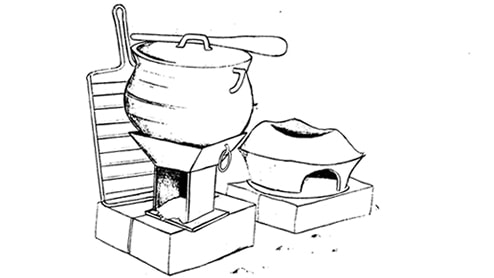
Introduction to Togolese cuisine
The Togolese culinary know-how is an art that is transmitted from mother to daughter. Every African girl has the obligation (the kitchen being part of the arsenal of seduction) to acquire this knowledge and transmit it. The kitchen fulfills a very important function of social cohesion and is distinguished by the use of multiple products.
Indeed, the preparation of meals is a special moment during which the bonds between mothers and daughters are strengthened (keeping the notion of a large African family). Unlike western cuisine that is performed standing, Togolese cuisine is seated which explains why the area of the kitchen Togolese is furnished with small stools because we sit to cook.
During this privileged moment, when women meet each other (every man who dares to enter the sanctuary is thrown out unceremoniously), long talks on various topics and small tricks are exchanged on how to use the wide range ingredients that make up the richness of Togolese cuisine (a cuisine that according to the criteria today would have the organic label). The ingredients come from farming, breeding, fishing and hunting (not important).
Agriculture provides a large part of Togolese food security. The territory of Togo is 25% cultivated. The rural sector still supports about 80% of the population. The crops are very diverse: vegetables (corn, tomato, eggplant, pepper, pepper, tomato, green beans, carrots, okra, ademe), fruits (lemon, orange, grapefruit, olive, avocado, banana, kiwi, mango, avocado, pomegranate, date, cashew, coconut, nutmeg, papaya, tangerine, tamarind, saponier, carambola, cocoa, soursop, pineapple, cherimoya, date or apple cinnamon), cereals (millet, sorghum, rice and fonio, maize) are grown without chemicals … In Togo we use wood (and charcoal) as fuel, the cause of a high rate of deforestation.
These products are accompanied and supplemented by a protein intake from livestock (cattle, sheep, goats, poultry). Beef, mutton, goat, goat, hind, agouti rabbit are also part of the Togolese diet without forgetting poultry (chicken, guinea fowl, turkey, duck).
The food is healthy because we cook with natural products; Livestock and Poultry are fed with products of nature. The Togolese fauna consists of about forty animal species that we do not necessarily consume: elephants, antelopes, warthogs, monkeys, lions, buffaloes, horses, giant Pythons, crocodiles, caimans , varieties of birds, and many other kinds of reptiles.
We also consume saltwater and freshwater fish because the southern facade of Togo is open on the Gulf of Benin (Atlantic Ocean) in addition to many lakes, the largest of which is Lake Togo; To the north-west of the Ouatchi plateau is the basin of the mono and north of the mountains Togo, Oti. Fishing is a very old activity in Togo. Commonly eaten fish are doevi (fry), panpan (harangue), afohome (sole) tsiyi and akpala (horse mackerel) tan (skate) gesu (mullet) sikasika (pageot), eka (bar), salomon (mackerel,) lizi ( pike), vetsim (sardinella), manvi (herring) … And crustaceans, molluscs are crabs, shrimp, oyster, mussel.
With all this wealth, the Togolese have developed a very rich repertoire of dishes, as well as a culinary art unique to the West African seaside countries. Each dish transports us into a world of unique flavor, as it relates to a particular memory and illustrates the cultural diversity of our beloved nation.